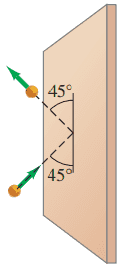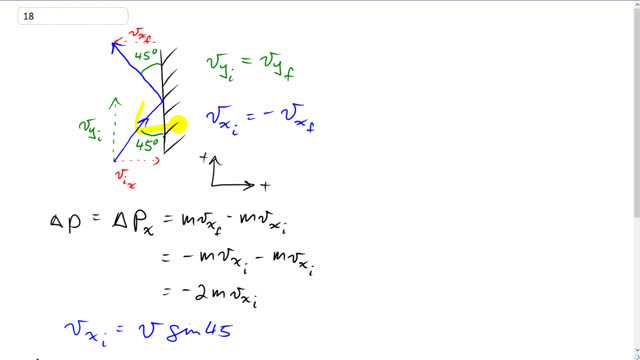
A tennis ball of mass and speed strikes a wall at a angle and rebounds with the same speed at (Fig. 7–32). What is the impulse (magnitude and direction) given to the ball?


In order to watch this solution you need to have a subscription.
This is Giancoli Answers with Mr. Dychko. Before and after colliding with a wall, this ball has the same angle with respect to the vertical— it's still 45 degrees here with respect to vertical initially— and then its velocity is 45 degrees with respect to vertical after colliding with a wall. So in both cases, given that it has the same speed we are told, the vertical component of its velocity will be the same in both cases and so that means it doesn't change at all. However, the x-component of its velocity has the same magnitude in both cases but technically, the velocity does change because its direction changes and so it has a different sign. So we'll take positive to be to the right and upwards as well. So the initial y-component of the velocity is the same as the final y-component of the velocity as I was saying and the initial x-component of its velocity is the negative of the x-component of its velocity after colliding with the wall; same magnitude, opposite direction. So impulse then is gonna be just to do with the x-direction, there is no change in momentum in the y-direction so that's why we can say this. Normally, impulse would be the vector sum of the impulses in each component in each direction so we would normally have to do Pythagoras to get the impulse but in this case, there is no impulse in the y-direction so this is just the square root of ΔP x squared which is just ΔP x as I have written here. Okay. And so we have m x-component velocity final minus m x-component velocity initial and then we substitute in negative v x i in place of v x f based on this. I guess, you know, more precisely I could have written v x f equals negative v x i but it's the same idea so this is the substitution I just made here. And well these two terms are the same so we collect them and that makes negative 2m v x i. So x-component initial of the velocity is the velocity multiplied by sin 45 in this triangle here, the x-component is the opposite leg and we have negative 2 times 0.06 kilograms— mass of the ball—times its initial speed of 28 meters per second times sin 45 that gives negative 2.4 kilograms meters per second. So that's an impulse of 2.4 kilograms meters per second away from the wall.
Thank you! I followed that and it made perfect sense.